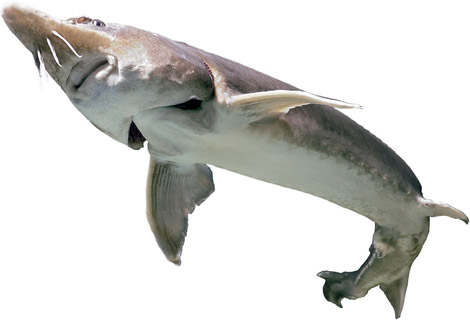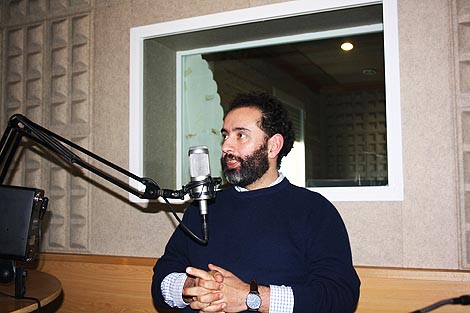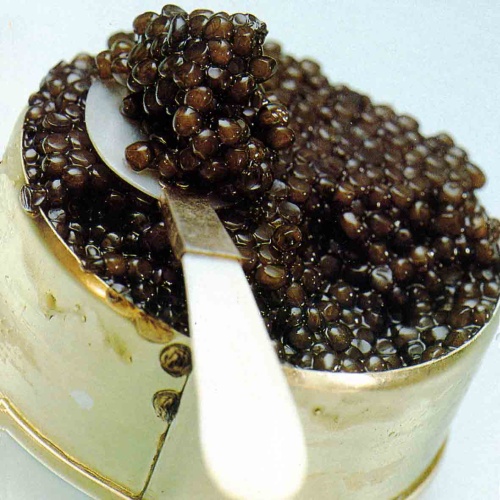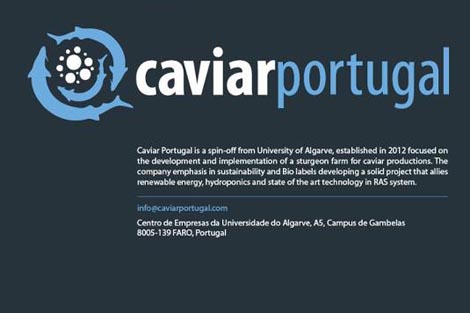 There are already sturgeon babies thriving in ponds in a room at the University of the Algarve (UAlg). The project caviar Portugal took concrete steps to make a business of producing the precious caviar in Portugal a reality, which could have a millionaire return with the acquisition of the first specimens.
There are already sturgeon babies thriving in ponds in a room at the University of the Algarve (UAlg). The project caviar Portugal took concrete steps to make a business of producing the precious caviar in Portugal a reality, which could have a millionaire return with the acquisition of the first specimens.
This first batch will serve to start a small production unit, still far from the potential that project managers believe can be achieved in the medium term.
It will also be a way to test technology and production techniques, as this is an innovative undertaking in Portugal.
For now, the investment is from the two project mentors, University of Algarve researcher Paulo Pedro and his partner in this venture Valery Afilov, a Ukrainian citizen who has a lot of experience in the production of this species of fish in aquaculture.
Paulo Pedro was in conversation with the Sul Informação and with University Radio of Algarve RUA FM in the Impressions program. In focus was, of course, the most recent development of the project, the arrival of what were supposed to be sturgeon eggs, but which when it arrived in Portugal «were already larvae», due to a problem with the supplier.
A situation that ended up having a happy ending, but that draws attention to another of the business risks: the fact that you are dealing with living beings. “Right now, we have babies, but even babies. Eggs were supposed to have arrived, but, due to the difficulties in transport, larvae have already arrived”, he revealed.
“It was a great stress two weeks ago, as everything related to transport got complicated. The contract we had was for the eggs to be laid here in Faro. But, two days before the hatching of the larvae, they said they couldn't guarantee transport, we had to pick them up in the Netherlands», he said.
 "You can't bring it by plane, so we had to send someone, who had to handle a very urgent transport under special conditions," he said.
"You can't bring it by plane, so we had to send someone, who had to handle a very urgent transport under special conditions," he said.
Everything ended up going well and the babies are already installed and growing. «Initially we had 40 eggs and, if all goes well, I believe we will have 10 fish. But I'm hoping to achieve a lot more,” he added.
At this moment, the specimens resemble "tadpoles" and weigh, as a whole, "40 milligrams" and will still take three years to grow and reach the point of producing eggs. Until then, Paulo Pedro will find a space to accommodate them, which he is still looking for. “Right now we have a 50 square meter facility, which can be used as a maternity ward, but cannot be fattened”, he explained.
“If we think that we can have ten thousand fish and that they will have an average of three kilos when they reach sexual maturity, we are talking about 30 tons of fish”, he recalled. “There is a second phase here, the location of which is not yet fully closed. But we can even do a pilot installation, which would already allow us to have a product to show on the market, with our own resources», he said.
This is just a very small portion of the project that the two partners want to implement. «The large project we want to develop involves an investment of around 3 million euros. This is not a lot of money for big investors, but it is beyond our reach without outside help,” he explained.
Business has risks, but Paulo Pedro believes in success
 The project caviar Portugal it is not without risks, not least the fact of dealing with living beings, but also the high investment and, above all, the time it takes to give a return, which will never be less than “7 or 8 years”.
The project caviar Portugal it is not without risks, not least the fact of dealing with living beings, but also the high investment and, above all, the time it takes to give a return, which will never be less than “7 or 8 years”.
On the other hand, the one with the advantages, is the price of caviar at the exit of the production unit, which at the moment «around a thousand dollars per kilogram». Being an endangered species, without being on the black market it is only possible to find caviar coming from fish raised in captivity. Sturgeon meat also has an interesting market price, with an average price of 10 euros per kilo.
As for the production risks, Paulo Pedro trusts in his own technical and scientific capacities and that of his partner, not least because he is already “up to his neck in this”, on a financial level. But it is not always easy to give assurances to potential investors, namely that there will be no others trying to do the same in the region.
“There's a lot of information you can't get from books, which doesn't mean you can't find the people who have it. When we started researching we realized that there are many secrets that are not told. That's why there were cases of failure in this type of aquaculture. Bad technology choices or even some lack of humility, thinking it's simple,” he said.
«The type of aquaculture that we propose to do is different from the traditional one in creek or covered [land tanks]. We are talking about a completely different technology, with water recirculation systems, in a completely controlled environment. It's an industrial aquaculture,” he said.
Another thing that distinguishes this aquaculture from the many that already exist in the Algarve, on land or offshore, is the fact that it uses fresh water, «which has a major implication in terms of licensing».
Caviar Portugal was born in a UAlg ideas competition
 The project caviar Portugal was created in 2010 within the scope of the contest «Ideias em Caixa», promoted by the CRIA – Entrepreneurship and Technology Transfer Division UAlg with the sponsorship of Caixa Geral de Depósitos. And, curiously, it wasn't even supposed to be the project that Paulo Pedro was going to present to the competition.
The project caviar Portugal was created in 2010 within the scope of the contest «Ideias em Caixa», promoted by the CRIA – Entrepreneurship and Technology Transfer Division UAlg with the sponsorship of Caixa Geral de Depósitos. And, curiously, it wasn't even supposed to be the project that Paulo Pedro was going to present to the competition.
«I'm a Marine Biologist, but I knew very little about sturgeon. I understand something now, having been in this for three years. Before, there was the basic concept, which is a cold-water fish from Russia, the caviar fish. I never thought of getting involved in a sturgeon aquaculture», he confessed.
Everything changed when he met Valery Afilov. After having carried out a water analysis for what would become his partner in this project, he became interested in his idea of raising sturgeon in Portugal.
“I saw that he was a person who was very well documented in technical terms and that the scientific information he had was very up-to-date. I did my research and realized that it made perfect sense, considering some of the advantages of producing here», he revealed. Advantages that it doesn't reveal, “because otherwise everyone wants to have the same business” (laughs).
“Valery is Ukrainian and for 12 years had been granted a sturgeon aquaculture in a dam in Ukraine and already had a lot of experience working with sturgeon. He came to Portugal to work in Civil Construction and spent a few years trying to convince other people to get involved in this», he said. After taking the denial of the banks, Paulo Pedro offered to help look for solutions.
«Two months later, Ideias em Caixa appeared. I was involved in a completely different area and developing another business plan and I arrived there a day before the closing of the applications and I thought: the sturgeon, maybe, was a good idea to submit», he said.
Paulo Pedro and Valery Afilov got together and submitted the idea. «What was my surprise when I learned that it was one of the ideas that was causing the most enthusiasm» and that it ended up winning in the Sea category. «I lost much more time on the other idea, which also ended up winning, than with this one,” he said.


















Comments